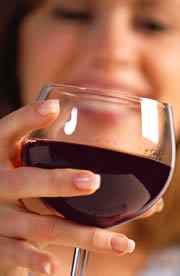
| El vi |  |
Artícles
Red wine ingredient makes yeast live longer
Baker's bug hints at health benefit of plant compounds.
26 August 2003
HELEN R. PILCHER
 |
---------- |
An ingredient of red wine extends lifespan by up to 70% - in yeast1. The compound seems to
mimic the age-enhancing effects of calorie restriction on the single-celled organism.
Capitalizing on the chemical, called resveratrol, is a long way off in humans, says
David Sinclair of Harvard Medical School in Boston, Massachusetts, who led the research.
To match the yeast doses, he says, humans would need to drink a glass of their favourite
vintage morning, noon and night.
But the research may help explain why red-quaffing Mediterraneans live to a ripe old age.
Resveratrol boosts levels of an enzyme called Sir2, which is thought to extend lifespan
by stabilizing DNA. "It's highly plausible that boosting enzyme activity will slow functional
decline in old age," agrees Peter Piper, who studies ageing at University College London. |
Resveratrol is one of a group of chemicals called polyphenols. Previous research has suggested
that these can protect against heart disease and osteoporosis in humans. "It may not be just a
longer life - it may also be a healthier one," says Sinclair.
The compound is one of 17 plant molecules so far found to extend life in baker's yeast
(Saccharomyces cerevisiae). Resveratrol also gives fruitflies, which typically live for
around a month, an extra ten days of life, says Sinclair. Studies on mice are in the pipeline.
Sinclair gave his yeast fresh grape extract. Normally, the organism divides around 25 times
and then dies. Resveratrol-treated yeast underwent an extra 15 replications.
Many polyphenols are also found in tea, fruit and vegetables, says Piper. "It stresses the
importance of eating a healthy, balanced diet," he says. Pharmacologists are also developing
a stable, slow-release resveratrol pill.
|Article|
http://www.nature.com/nsu/030825/030825-1.html
References
Howitz, K. T. Small molecule
activators of sirtuins extend Saccharamyces cerevisiae lifespan.
Nature, published online, doi:10.1038/nature01960 (2003).
© Nature News Service / Macmillan Magazines Ltd 2003